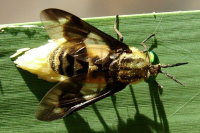Phylum Arthropoda (Arthropods) ➔ Subphylum Hexapoda (Hexapods) ➔ Class Insecta (Insects) ➔ Order Diptera (True flies) ➔ Family Tabanidae (Clegs, deer flies, horse flies)
Chrysops relictus Meigen, 1820
Goldaugenbremse Twin-lobed Deerfly
Synonyms and other combinations:
Chrysops chlorosis Goffe, 1931 | Chrysops clarus Goffe, 1931 | Chrysops conspicuus Goffe, 1931 | Chrysops inconspicuus Goffe, 1931 | Chrysops melanopleurus Wahlberg, 1848 | Chrysops morio Zetterstedt, 1849 |
Classification:
Chrysops relictus belongs to the subfamily Chrysopsinae.Distribution:
Europe, Russia, China.Habitat:
Moist heaths, moors, light forests, pastures, often near stagnant waters.Description:
Length 9 - 14 mm; black and yellow; antennae long and slim; wings with brown pattern; discal cell brown, only slightly paler in the middle; anal cell closed; compound eyes conspicuously iridescent green with differently coloured spots.Male: Eyes meeting on frons (forehead); legs bicoloured, at least the posterior parts of the tibiae are brownish.
Female: Eyes clearly separated; legs brownish, at least on posterior part of tibiae.
Similar species:
There are some similar species in the genus. These differ in the abdominal pattern of the 1st and 2nd tergit.The Splayed Deer Fly Chrysops caecutiens differs from the Twin-lobed Deerfly Chrysops relictus by the coloration of the middle tibiae. These are yellowish brown in Chrysops relictus and black in Chrysops caecutiens.
Biology:
The adults of the Twin-lobed Deerfly Chrysops relictus fly from May to September.While the males feed on nectar and plant sap, the females need an extra blood meal to consume the proteins necessary for the development of eggs. Females suck blood from mammals, often cattle, horses and deer. The pictures from 2005 show a female laying eggs at the margin of a small pond.
The hydrophilic larvae develop under very humid conditions. They are saprophagous and live in decaying plant material.
References, further reading, links:
- Pape T. & Thompson F.C. (eds) (2017). Systema Dipterorum (version 2.0, Jan 2011). In: Species 2000 & ITIS Catalogue of Life, 2017 Annual Checklist (Roskov Y., Abucay L., Orrell T., Nicolson D., Bailly N., Kirk P.M., Bourgoin T., DeWalt R.E., Decock W., De Wever A., Nieukerken E. van, Zarucchi J., Penev L., eds.). Digital resource at www.catalogueoflife.org/annual-checklist/2017. Species 2000: Naturalis, Leiden, the Netherlands. ISSN 2405-884X.
- Michael Chinery: Pareys Buch der Insekten: über 2000 Insekten Europas, Verlag Kosmos, 2004, 326 Seiten, ISBN 3440099695, 9783440099698.
- E. Völlger, M. Jeremies: Bestimmungsschlüssel für mitteleuropäische Bremsen (Dipt., Tabanidae), Entomologische Nachrichten und Berichte, 29, 1985/1, 1-11.
- Stjepan Krčmar, Davorka K. Hackenberger, Branimir K. Hackenberger: Key to the horse flies fauna of Croatia (Diptera, Tabanidae); Periodicum Biologorum, Vol. 113, Suppl 2, 2011, ISSN 0031-5362.
- Martin Grassberger: Tabanidae (Bremsen), in: H. Aspöck (Hrsg.): Krank durch Arthropoden, Denisia 30 (2010): 261–266.
- J. W. 0. Ballard and J. K. Waage: Feeding strategies of the horseflies Hybomitra expollicata and Tabanus bromius in southern France, Medical and Veterinary Entomology (1988) 2, 265-270.
- M. Mally und E. Kutzer: Zur Tabanidenfauna Österreichs und Betrachtungen zu ihrer medizinischen Bedeutung, Mitt. Österr. Ges. Tropenmed. Parasitol. 6 (1984) 97-103.


